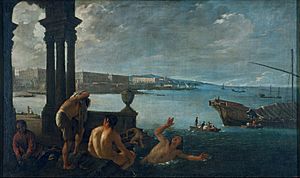Antoni Viladomat facts for kids
Antoni Viladomat i Manalt (born March 20, 1678, died January 22, 1755) was an important painter from Catalonia, a region in Spain. He lived and worked in Barcelona. Antoni Viladomat painted in the exciting and dramatic style known as Baroque.
Biography
Antoni's father worked as a gilder, someone who applies thin layers of gold to objects. Antoni started learning art in the workshop of Pasqual Bailon Savall. Pasqual was from Berga, just like Antoni's father.
When Pasqual Bailon Savall died young, Antoni became an apprentice to Joan Baptista Perramon. He stayed with Perramon for at least six years, possibly even nine. After that, he worked on the Church of San Miguel with the painter and architect, Ferdinando Galli-Bibiena. This experience helped him learn about Italian art.
In 1723, Antoni had a disagreement with the "Colegio de Pintores," which was like a painters' club or guild. This group had very strict rules. Antoni wanted to be a "licensed painter" so he could work freely. He went to court and won his case. However, problems continued, and he had to go to court again in 1739 to keep his title.

Antoni Viladomat had a long career and painted in many convents and monasteries in Barcelona. One of his most famous works is a series of twenty paintings about the life of Saint Francis of Assisi. These were originally made for an old Franciscan monastery between 1722 and 1724. Today, you can see them at the Museu Nacional d'Art de Catalunya (National Art Museum of Catalonia).
He also created a series of forty paintings showing the Stations of the Cross and scenes of the Virgin Mary. These are kept in the Basílica de Santa Maria de Mataró. These two large collections make up most of his artwork that we still have today. Some paintings that were thought to be his, at the Old Hospital de la Santa Creu and a Jesuit Church in Tarragona, are now being questioned by art experts.
Besides painting, Antoni also taught drawing in his workshop. Many young artists wanted to learn from him. His son, Josep Viladomat i Esmandia (1722-1786), also became a painter. Josep was well-known for his own series of paintings, done in his father's style, about the life of Saint Thomas Aquinas.
See also
 In Spanish: Antonio Viladomat para niños
In Spanish: Antonio Viladomat para niños



